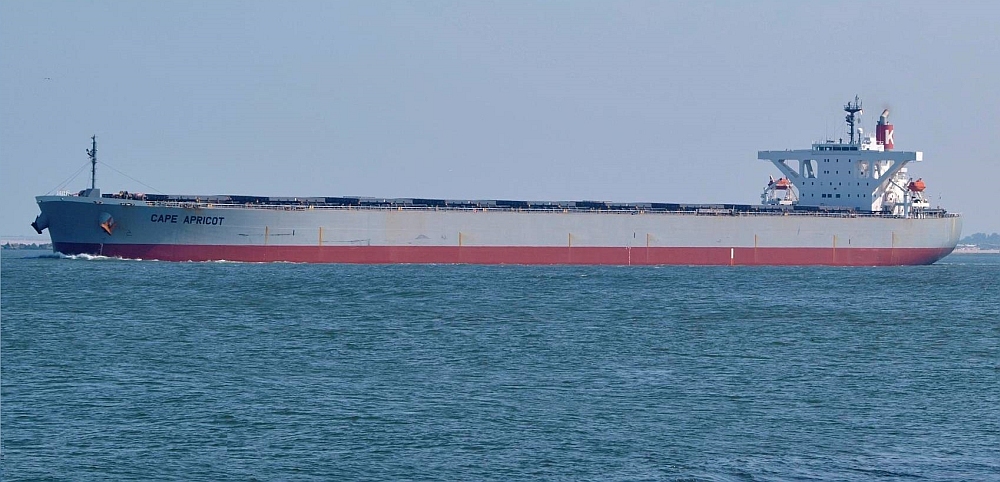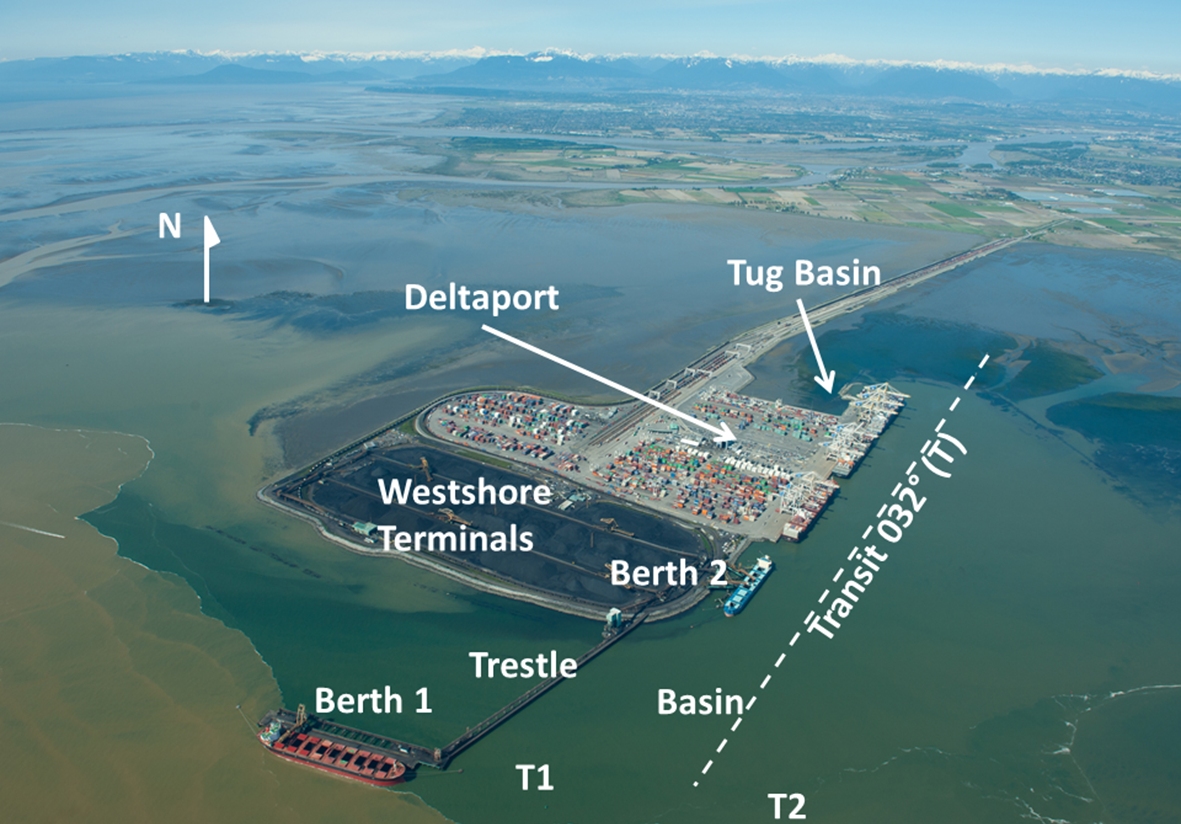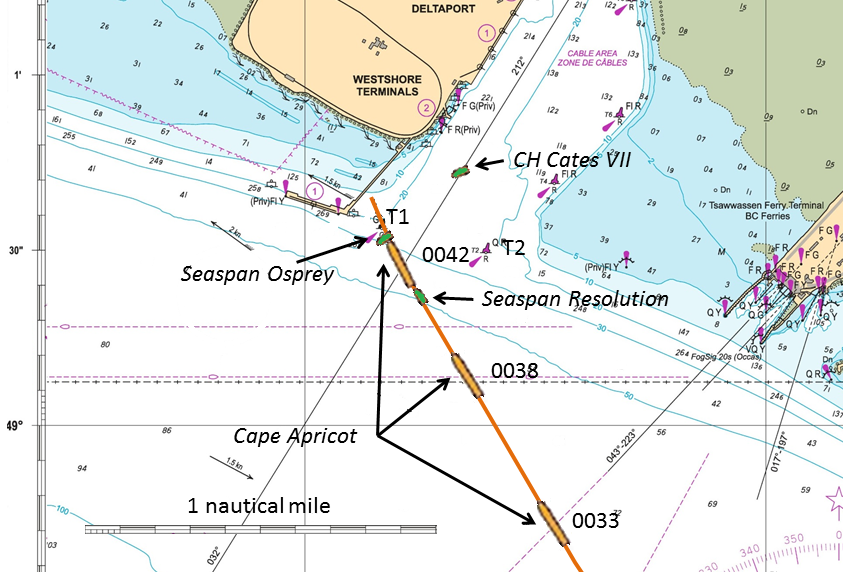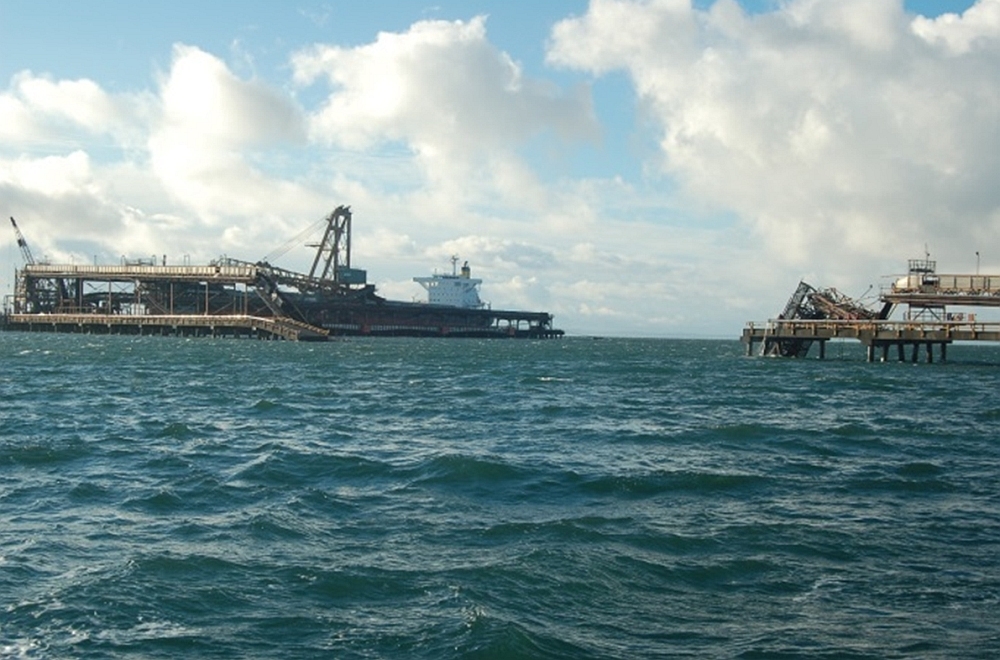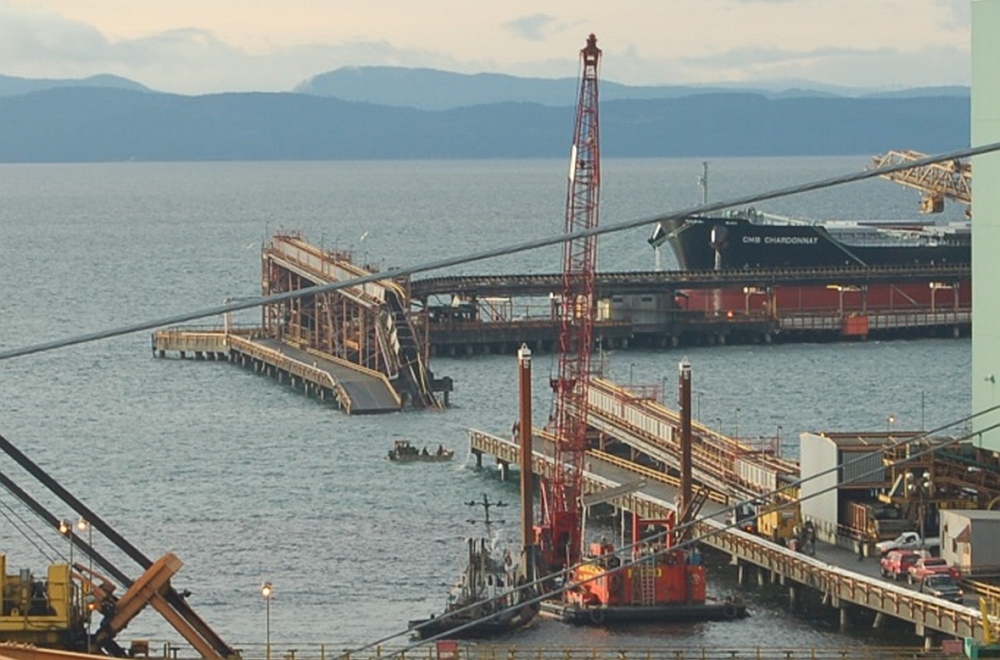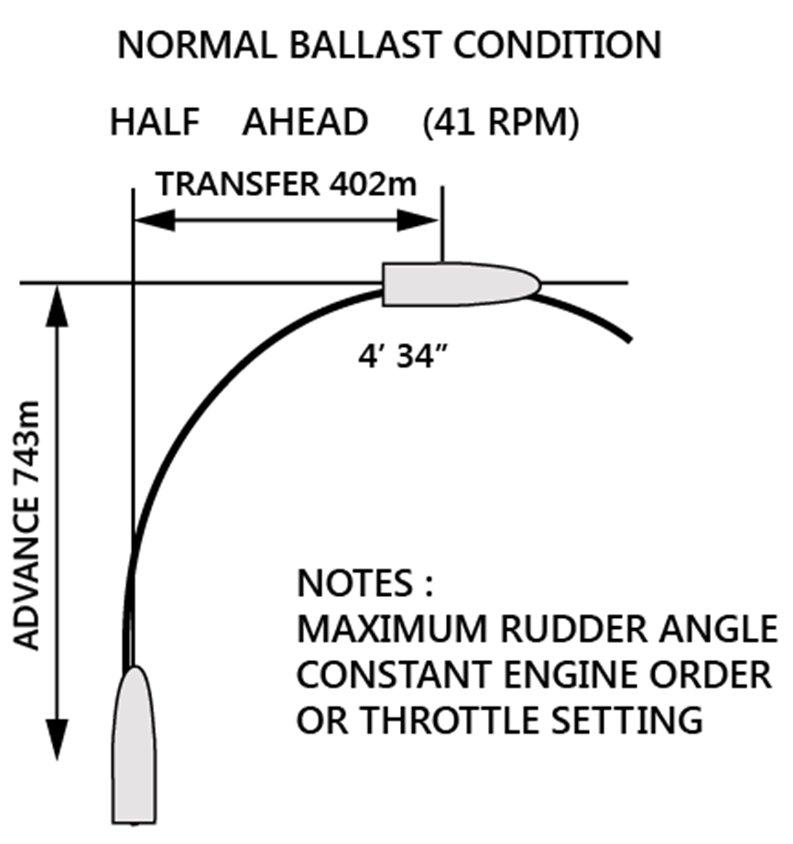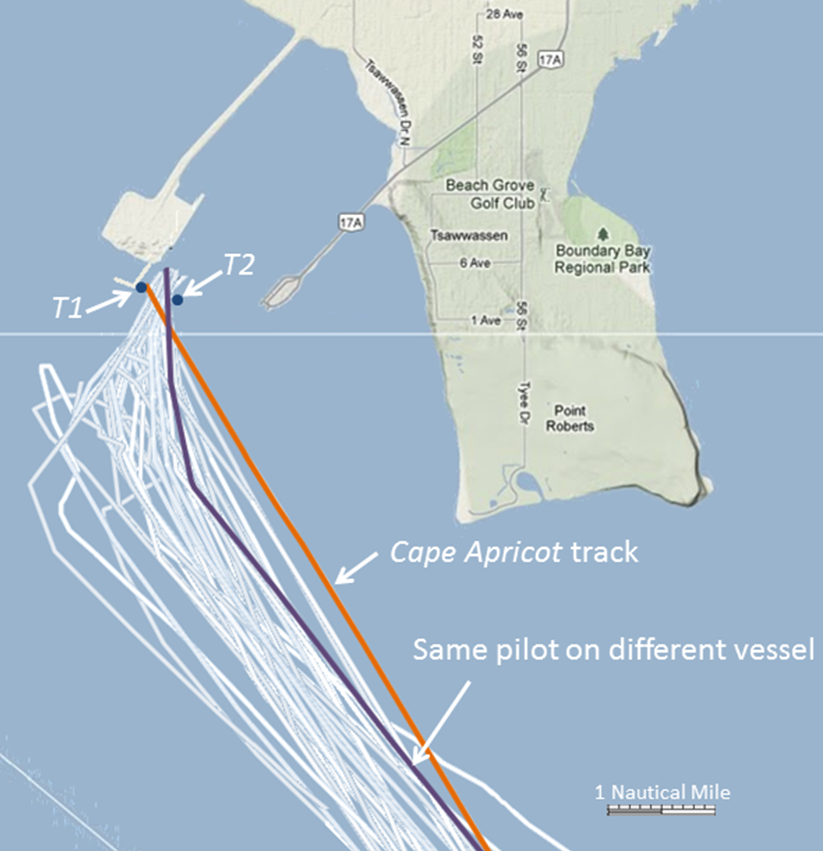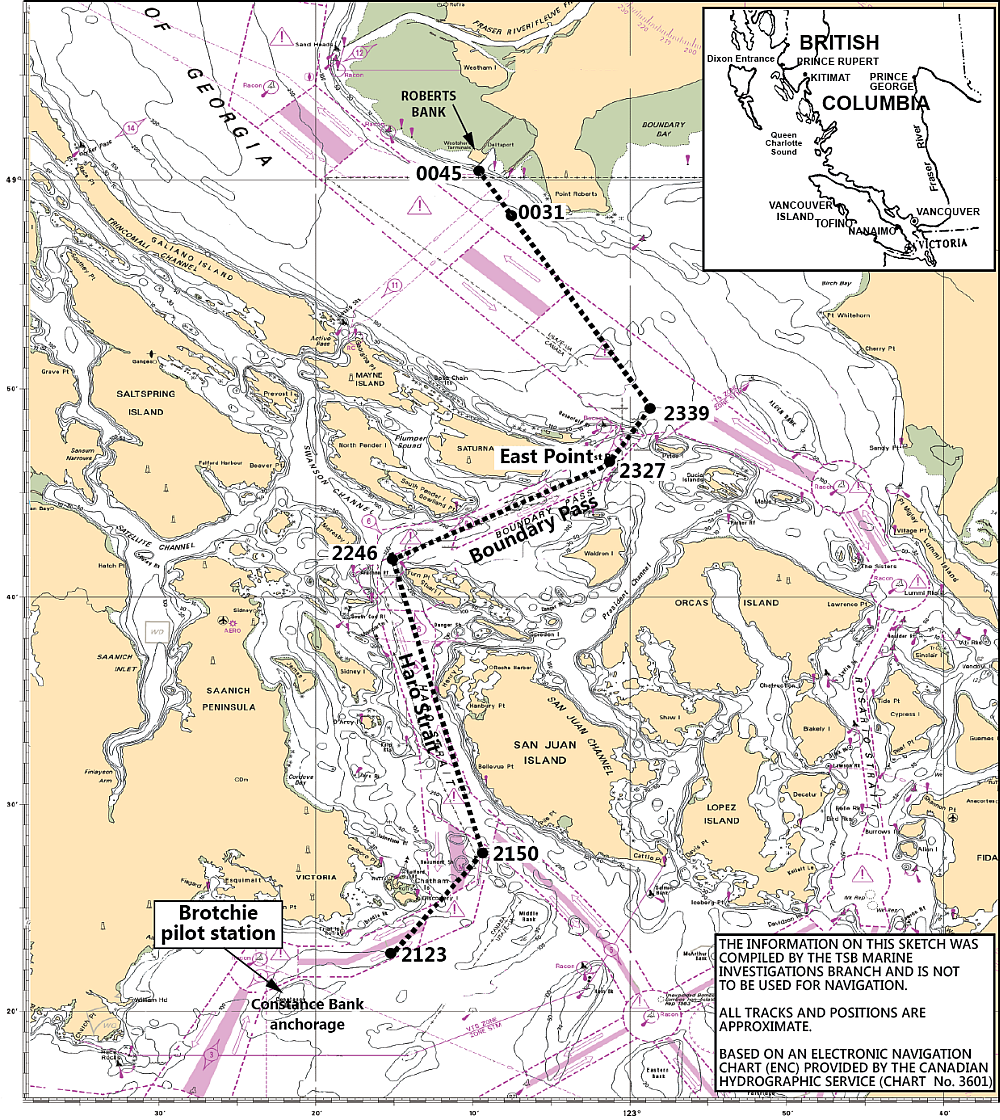Striking of Terminal
Bulk Carrier Cape Apricot
Roberts Bank, British Columbia
The Transportation Safety Board of Canada (TSB) investigated this occurrence for the purpose of advancing transportation safety. It is not the function of the Board to assign fault or determine civil or criminal liability. This report is not created for use in the context of legal, disciplinary or other proceedings. See Ownership and use of content. Masculine pronouns and position titles may be used to signify all genders to comply with the Canadian Transportation Accident Investigation and Safety Board Act (S.C. 1989, c. 3).
Summary
On 07 December 2012 at 0045 Pacific Standard Time the bulk carrier Cape Apricot, while under the conduct of a pilot, struck the causeway and conveyor system connecting Westshore Terminals berth 1 to the main terminal at Roberts Bank, British Columbia. As a result of the impact, the causeway and conveyor collapsed into the water, and the vessel's bow sustained damage. There was minor pollution and no injuries.
Factual information
Particulars of the vessel
| Name of vessel | Cape Apricot |
|---|---|
| IMO number | 9311828 |
| Port of registry | Panama |
| Flag | Panama |
| Type | Bulk carrier |
| Gross tonnage | 90 091 |
| LengthFootnote 1 | 288.93 m |
| Draught at time of occurrence | Forward: 6.99 m Aft: 8.80 m |
| Built | 2004, Koyo Dockyard Co. Ltd., Japan |
| Propulsion | 1 main engine (17 700 kW) driving a fixed propeller |
| Cargo | Ballast |
| Crew | 22 |
| Registered owner | Leo Ocean SA, Japan |
| Manager | Tokei Kaiun KK, Japan |
Description of the vessel
The Cape Apricot is a gearless bulk carrierFootnote 2 built of steel with the machinery spaces and accommodation aft (see Photo 1). The vessel has 9 cargo holds and hatches. A bulbous bow encloses the forepeak water ballast tank, and a collision bulkhead segregates the forepeak from the cargo holds.
The bridge is equipped with the required navigational equipment, including an automatic identification system (AIS)Footnote 3 and 3 cm and 10 cm radars with automatic radar plotting aid (ARPA) capability. The steering stand is located on the centreline of the vessel. On the port side of the steering stand is a console that includes the bridge telegraph. The vessel is also fitted with a voyage data recorder (VDR).
Westshore Terminals Limited
Westshore Terminals Limited is a coal export facility located on Roberts Bank, a man-made island (see Photo 2) situated in the Strait of Georgia near the Tsawwassen ferry terminal south of Vancouver, BC. A container facility, known as Deltaport, is also located on Roberts Bank.
Westshore Terminals Limited exports coal from 2 berths. Berth 1 is connected to the main terminal via a trestle that supports both a causeway and coal conveyor system. The trestle is comprised of piles that are located at intervals of 18.29 m and joined together by pile caps. It extends into the water from the southwestern corner of Roberts Bank. Berth 2 is located on the island itself. Westshore Terminals Limited is designed to export 33 million tonnes of coal per year. The highest export year was 2012, when 33 million tonnes was exported.
History of the voyage
On 03 December 2012, the Cape Apricot arrived in ballast at Constance Bank anchorage off Victoria, BC, awaiting a berth at Roberts Bank in order to load coal. On 06 December, Westshore Terminals berth 2 became available for the Cape Apricot, and the vessel commenced heaving anchor at 2020Footnote 4 to depart for the Brotchie pilot station in Victoria to pick up the pilot.Footnote 5 On the bridge were the master, the third officer acting as officer of the watch (OOW), and a helmsman.
After the pilot boarded the vessel at 2102, he and the master exchanged information about the intended berthing manoeuvre at Westshore Terminals berth 2, which entailed the tugs joining the vessel outside the basin, making a starboard turn, entering the basin and then using tugs to turn the vessel off the berth. The master-pilot exchange card and the pilot card were completed and signed by both the master and pilot. Following the master-pilot exchange, the pilot set up his portable pilotage unit (PPU) in order to monitor the vessel's progress. The vessel continued its voyage, passing East Point at 2327 and exiting Boundary Pass at 2335. During the passage, the port anchor was prepared for use in case of an emergency.
As the Cape Apricot entered the Strait of Georgia, the pilot steadied up on a course of 325° gyro (G) for a direct approach to Westshore Terminals, which was 13.3 nautical miles (nm) ahead.Footnote 6 At approximately 2345, the pilot attempted to contact the tugs at Roberts Bank to inform them the Cape Apricot would be 15 minutes ahead of schedule; he used various channelsFootnote 7 on the very high frequency (VHF) radiotelephone but was unsuccessful in making contact. As the Cape Apricot approached Point Roberts, the pilot gave notice for manoeuvring speed in order to slow the vessel down and, at 0022, he ordered half ahead.
Three tugs were scheduled to assist the Cape Apricot for berthing: the Seaspan Resolution, the Seaspan Osprey, and the C.H. Cates VII, which was to assist with mooring lines. At 0023, the Seaspan Resolution and the C.H. Cates VII departed the tug basin to meet the vessel, at which time the pilot was able to contact the Seaspan Resolution and communicate his intentions. At 0031, the vessel was approximately 1.4 nm SSE of the Westshore Terminals trestle when the pilot ordered the engine to be stopped. At 0035, the third tug, the Seaspan Osprey, departed the tug basin to meet the vessel. By 0038, the Cape Apricot was south of buoy T2,Footnote 8 its bow was 5.2 cables from the trestle (Figure 1) and the Seaspan Resolution was at the stern. At this time, the vessel's speed was 5.4 knots and the heading was 327°G. Approximately 1 to 3 minutes later, when the vessel was between 1.9 to 0.5 cables from the transit leading into the basin,Footnote 9 the pilot ordered the rudder hard to starboard, but the vessel's response was minimal. At the time of the order, the rudder was already hard to starboard. At 0040, the pilot made a call on his mobile phone.
By 0042, the Seaspan Resolution's line was made fast on the Cape Apricot's stern and the pilot ordered the slack to be taken out of the line. The C.H. Cates VII was standing by. The Seaspan Osprey was alongside the port shoulder of the Cape Apricot, approximately 1 minute later, at which time it was requested to push easyFootnote 10 by the pilot. The bridge of the Cape Apricot then crossed the transit and the pilot ordered the Seaspan Resolution to pull half, straight astern.
At approximately 0044, as the Seaspan Osprey was pushing the Cape Apricot, the tug's master noticed the trestle being illuminated by the tug's deck lights. He then used the VHF radiotelephone to contact the pilot and warn him that the Cape Apricot was getting close to the trestle. Around the same time, the chief officer, who was stationed for line handling on the Cape Apricot's bow, informed the master that the trestle was approximately 50 m from the vessel's bow. When the Seaspan Osprey master warned the pilot of the vessel's proximity to the trestle a second time, the pilot ordered the Seaspan Resolution to pull full in the astern direction and the Seaspan Osprey to push full. Either shortly before or during the last communication, the pilot ordered dead slow astern on the main engine and then gave orders of slow, half, and full astern within the next 30 seconds.
At 0045 the Cape Apricot struck the trestle on a heading of 344° True (T) at a speed of approximately 3.5 knots. The master of the Seaspan Osprey had backed off the Cape Apricot shortly beforehand in order to avoid damage to his own vessel. A 128 m section of the trestle collapsed upon impact, and the vessel proceeded about 35 m through the way of the trestle before coming to a stop.
Through a combination of engine movements and assistance from the tugs, the Cape Apricot backed out of the trestle at approximately 0048 and pulled out to the basin in order to proceed to berth 2. The vessel turned off berth 2 with the assistance of the tugs and docked at 0245.
Damage to the vessel
Damage to the bow section of the Cape Apricot was limited to the forepeak tank. A survey by the classification society carried out following the occurrence identified the following:
- a dent on the stem plate between frames 327 and 331
- buckling on 3 side longitudinals, which also extended to the associated stiffeners and No. 2 port stringer between frames 327 and 331
- a dent on the stem plate located above the No. 2 port stringer between frames 322 and 326.
Damage to the terminal
Damage to the terminal was extensive; approximately 128 m (6 pile sections) of the causeway to berth 1 collapsed into the water, and the damage to the coal conveyor system extended approximately 145 m (see Photo 3 and Photo 4). Furthermore, services to berth 1 (including electrical power and fresh water) were cut off at the time of the striking, rendering the berth temporarily inoperable. A quantity of coal, estimated at less than 30 tonnes, also entered the water.
The berth was back in service 2 months later and repairs to the causeway were completed in late April 2013.
Personnel certification and experience
The crew of the Cape Apricot were all certified for their positions on board.
The master had 12 years of experience as a deck officer and had made his first voyage as chief officer in 2008. He had been promoted to the position of master in November 2011 when he joined the Cape Apricot. The master had received bridge resource management (BRM) training in the Philippines. He had not previously docked at Westshore Terminals.
The OOW had been sailing as a deckhand and apprentice since 2001 and obtained his certificate as officer in charge of a navigational watch in March 2012. He had joined the Cape Apricot as a deckhand in April 2012 and had been promoted to third officer in September 2012.
The helmsman had been sailing since 2009 and joined the Cape Apricot as a helmsman in April 2012.
The pilot on the Cape Apricot had obtained his licence as Pilot, Class II in 1993. In 1994, he obtained his Class I, Unrestricted licence. Since June 2009, the pilot had docked 4 other similar types of vessels from the same direction (southerly approach) at Westshore Terminals berth 2, and he had docked 21 vessels at other berths at Roberts Bank. The pilot had completed a BRM course and held a valid medical certificate.
Vessel certification
The Cape Apricot was certificated and equipped in accordance with existing regulations.
Environmental conditions
The weather around the time of the occurrence was overcast with occasional rain. The visibility was good and, in the hour preceding the striking, the wind was veering from SSE to SSW at 16 knots near Roberts Bank.
The current off Roberts Bank runs along the shoreline and follows the general direction of the Strait of Georgia; as such, an ebbing current sets to the southeast and a flooding current to the northwest. The speed of the current is affected by the mixed semidiurnal tides.Footnote 11 While the Cape Apricot was transiting from East Point, the current was primarily in a northwesterly direction, but it turned to a southeasterly direction just after midnight.Footnote 12
Vessel manoeuvring characteristics
The vessel's manoeuvring information on the bridge indicated that, for a starboard turn made under normal ballast conditions with maximum rudder angle and the engine half ahead (41 revolutions per minute), the vessel's advance would be 743 m (or 4.0 cables) and the transfer would be 402 m at 90° heading change (Figure 2).
If the heading change was less than 90° or if the rudder angle or engine orders differed from the ones specified above, the transfer and advance distances would be affected. The diagram supplied with the Cape Apricot was not sufficiently detailed to measure these values. When compared to other bulk carriers of a similar size, for a heading change of 65°, the advance value would be between 80 to 92 percent of the 90° course change value.
Approaches to Westshore Terminals berth 2
Approaches to Roberts Bank are determined by local pilots based on various factors such as the type of vessel, the berth to be used, environmental conditions (i.e., wind and current), the availability of tugs, and other vessel traffic information.
Three tugs are on hand at Roberts Bank to assist with vessel movements. They are stationed in the tug basin near Deltaport. Generally, when a vessel scheduled to berth at Westshore Terminals requires the assistance of tugs, the tugs are ordered and a crew is assigned. Once the crew is on board, the tugs then monitor the AIS for the inbound vessel's arrival time. Pilots can also communicate directly with the tugs through VHF radiotelephone. Ordinarily, tugs join incoming vessels that are bound for berth 2 outside the basin and west of buoys T1 and T2, but they sometimes join as late as inside the basin.
In order to compare the Cape Apricot's approach with other approaches to Westshore Terminals berth 2, the Transportation Safety Board (TSB) obtained AIS tracks for 35 of the 44 vessels that had docked there between 30 November 2011 and December 2012.Footnote 13 For each approach, environmental information (wind and current) was collected. The 35 tracks were then plotted to show the different approaches to berth 2 (see Figure 3). Of these 35 approaches, 6 were made in environmental conditions (wind and current) similarFootnote 14 to those experienced by the Cape Apricot around the time of the occurrence. The Cape Apricot's track was the closest track to Point Roberts, meaning that it required the largest change of course in order to enter the basin on the transit. The data included also 1 other approach made by the same pilot while on board a bulk carrier of the same type as the Cape Apricot.
Bridge resource management
BRM is the effective use of all resources, both human and technical, to accomplish a safe passage. BRM incorporates concepts such as workload management, problem-solving, decision-making, and teamwork. Two key aspects of BRM are communication and situational awareness.
In maritime pilotage operations, effective situational awareness involves 1) perceiving critical factors in the environment, 2) understanding what those factors mean with respect to controlling the vessel, and 3) projecting what will happen in the near future and taking appropriate action. Situational awareness is enhanced by good communication and, since a bridge team must work together toward a common goal, the exchange of information is necessary for the team to be effective.Footnote 15
BRM concepts extend to voyage planning and monitoring, in that all members of the bridge team must have a shared understanding of how a voyage will progress. When a pilot embarks, the pilot and master normally conduct a master-pilot exchange to help establish a shared mental model of the voyage, exchanging information on details such as intended courses and route, the speed of the vessel, where and when turns will be made, and how tugs will be used. If a pilot-master exchange does not cover all necessary details of the voyage, the master is unable to adequately monitor the vessel's progress and question the pilot if necessary.Footnote 16 The Standards of Training, Certification, and Watchkeeping Code emphasizes the importance of an ongoing exchange of information between master and pilot and states that “despite the duties and obligations of pilots, their presence on board does not relieve the master or officer in charge of the navigational watch from their duties and obligations for the safety of the ship.”
Footnote 17
In 1995, the TSB completed a safety study on the operational relationship between marine pilots and vessel masters/watchkeeping officers.Footnote 18 The objective of this study was to identify safety deficiencies associated with teamwork on the bridge, including communication between marine pilots and masters/officers of the watch. In this report, the Board noted that a pilot's decision-making “can become the weak link in a system prone to single-point failure; i.e., in the absence of effective monitoring, there is little safety backup for the pilot in the navigation of the vessel.”
Pacific Pilotage
On the west coast of Canada, responsibility for the operation, maintenance, and administration of pilot services for compulsory pilotage areas lies with the Pacific Pilotage Authority (PPA), a Crown corporation. The PPA does not directly employ pilots, other than those operating in the Fraser River. Rather, the PPA contracts a private company, the British Columbia Coast Pilots, Ltd. (BCCP) to provide pilotage services for vessels along the BC coast. The PPA sets the hiring and training standards for pilots and requires biennial medical examinations of all active pilots.
Pilot passage planning
The PPA leaves passage planning to the expertise of the individual pilot, who determines which courses to steer based on expertise, local knowledge, and an assessment of the environmental conditions for the voyage. The BCCP maintains that the use of navigational corridors is a more prudent practice than passage plans with specified tracks. For this reason, pilots are not required to have passage plansFootnote 19 or approaches to berths, nor are they required to establish abort pointsFootnote 20 and go/no-go areas. These requirements are only in place for high-risk passages, such as when tankers pass through Second Narrows and Boundary Pass.
The PPA has provided each member of the BCCP with a PPU. PPUs are portable electronic devices that allow pilots to use their own electronic charts and routes to assist in the navigation of vessels. Neither the BCCP nor the PPA place requirements on pilots as to how the software is to be used,Footnote 21 nor are there requirements as to whether passages should be planned on the PPU, whether the vessel's track should be recorded, or when the PPU's wide area augmentation system (WAAS)-enabled GPS antennaFootnote 22 is to be used (other than at Second Narrows).Footnote 23 In this occurrence, the pilot used the record feature in the software to record the vessel's track.
The TSB identified the issue of sharing pilot passage plans in an earlier report,Footnote 24 when the Board concluded that “the absence of a detailed, mutually agreed-upon passage plan deprives bridge team members of the means to effectively monitor a vessel's progress, compromising the principles of Bridge Resource Management.”
Footnote 25
In this occurrence, the pilot's approach to berth 2 differed from that marked on the vessel's voyage plan and was not marked on the vessel's charts.
Safety communication with pilots
The PPA has the ability to communicate with the pilots through Notices to Pilots (NtP) and has issued approximately 200 NtP since 1995, 156 of which are still active. The topics of these NtP range from operational issues to administrative policies. The NtP are disseminated in the form of a list, to which items are continually added. PPA is also working with the BCCP to implement a Safety Notification over and above its NtP. PPA indicates, however, that there are some legal concerns with implementing such a system.
The BCCP holds informal weekly meetings where pilots can drop in and discuss issues. Attendance at these gatherings is not mandatory and, given their work schedules, not all pilots are able to attend at the same time. As such, information from these informal gatherings does not necessarily reach all the pilots. The BCCP also sends information to the pilots by email and by weekly newsletter. The BCCP holds monthly formal meetings with its members and the minutes of these meetings are then circulated to all members. Prior to the occurrence, there had been no specific safety information regarding Roberts Bank disseminated to the pilots.
Risk and accident management
The contract between the PPA and BCCP establishes a safety and operating review committee (SORC) that includes members from both parties to review pilot ordering, dispatch efficiency, operating practices, and pilot working conditions. Although accidents are sometimes discussed during SORC meetings, these discussions have not resulted in definitive action. Between the PPA and the BCCP, there is no formal risk assessment process to evaluate pilotage operations, nor an accident review process to identify safety deficiencies, risks, and mitigations. Therefore, at an organizational level, there are no processes to learn from occurrences, share this information, implement corrective action, and reduce the risks to operations.
Safety management systems
A well-developed safety management system (SMS) enables organizations to identify and mitigate risks within their operations. All SMS have basic elements, including
- policies outlining roles and responsibilities and organizational commitment to safety;
- a formal framework for identifying risks;
- procedures to mitigate risks;
- a process for ensuring that personnel are trained and competent to perform their duties;
- a process for conducting periodic reviews or audits of the management system, both internally and externally;
- a process for the internal reporting and analyzing of hazards, incidents, and accidents and for taking corrective actions to prevent their recurrence; and
- a process for documenting all elements of the system.
Neither the PPA nor the BCCP have a comprehensive SMS. The PPA is presently in the process of implementing an ISO/ISM system for its operations. Part of implementing an ISO system will require its contractors to have such a system or something similar.
Voyage data recorder
Various modes of transportation use voice and data recorders to support an investigation into an accident or incident. Objective data are invaluable to investigators when seeking to understand the sequence of events and identify operational problems and human factors. The Cape Apricot was fitted with a VDR, as required by regulation.
The International Convention for the Safety of Life at Sea (SOLAS) requires that VDRs be tested annually by an approved testing or servicing facility. The last annual performance test certificate on board the Cape Apricot was dated 09 April 2012.
Although the crew pressed the button to save data on the VDR following the occurrence, initial attempts by the TSB to retrieve the VDR data were unsuccessful. At the TSB's request, the VDR was examined by a licenced service technician, who boarded the vessel 13 hours after the occurrence and determined that the VDR had stopped working prior to the striking due to a defective hard disc drive. As a result, there was no data relating to the occurrence. The event log obtained by the TSB indicated that technical problems with the VDR had occurred intermittently between 01 October 2012 and December 2012 and that a number of alarms had been acknowledged. No attempts to rectify these problems had been made prior to the occurrence.
Previous occurrences
The Board has previously identified instances where VDR data were unavailable for various reasons, including equipment defects, installation problems, and crews' unfamiliarity with the VDR's save function. A lack of VDR data has impeded investigative work on a number of occurrencesFootnote 26 and, as a result, the Board issued a safety concern stating that “when VDR data, in particular bridge audio recordings, are not available to an investigation, this may preclude the identification and communication of safety deficiencies to advance transportation safety.”
Numerous marine occurrence investigations worldwide have identified similar problems regarding malfunctioning or non-operational vessel VDRs.
Analysis
Events leading to the striking
Course of approach to Roberts Bank
Just before midnight on 06 December 2012, as the Cape Apricot was proceeding towards Roberts Bank, the pilot ordered a direct course towards the entrance of the basin. The 327° True (T) approach necessitated a course alteration of about 65° to starboard for the turn into the basin using the transit. This course of approach was more direct than other approachesFootnote 27 made by vessels docking at berth 2 that same year. The other courses, which were less direct, required a smaller course alteration to enter the basin.
Initiation of the turn
Given the Cape Apricot's direct course, more time and space was necessary to execute the turn into the basin than would be required for less direct angles of approach. The turn was initiated between 1.9 to 0.5 cables from the transit line into the basin; however, the turning circle of the vessel, given its speed, would have required a minimum distance of 3.2 to 3.6 cables to the transit line. Furthermore, the pilot had stopped the engine, reducing the effectiveness of the rudder, and the turn was not initiated at an adequate distance in order to complete it using only the vessel's rudder.
Use of tugs
In this occurrence, the large alteration with limited sea room would have required the tugs to assist early in the manoeuvre; however, the pilot had been unable to establish communication with the tugs using very high frequency (VHF) radiotelephone and the Seaspan Osprey departed the tug basin later than the other 2 tugs. Although the tugs were monitoring the Cape Apricot using automatic identification systems (AIS), the difficulties with VHF communication meant that the tugs were not advised to join the vessel earlier. As such, the tugs joined the Cape Apricot near the entrance to the basin, which was no longer optimal given the vessel's direct course and speed. The forward tug's effectiveness in assisting with the turn was therefore reduced, as the pilot had not ensured that both tugs were made fast or ready to assist prior to arriving near the basin.
Striking of the trestle
Despite the vessel's proximity to the trestle, its angle of approach, and the difficulties establishing communication with the tugs, the pilot continued the approach to the entrance of the basin without the tugs. In the absence of established abort points, the pilot and the master did not identify the developing unsafe situation, even when the vessel was less than a cable to the transit, on the original course of 327°T, with no tugs attached. That the pilot placed a telephone call while the vessel was approaching the entrance to the basin is an indication he did not recognize the impending situation. Furthermore, the bridge team did not intervene to safeguard the vessel during this phase of the approach. As such, the vessel struck the trestle at 0045 at a speed of 3.5 knots and on a heading of 344°T.
Bridge resource management
Bridge resource management (BRM) incorporates many concepts, one of which is effective communication to ensure that a pilot and bridge team have a shared mental model of how a voyage will progress. The master-pilot exchange is an opportune time for both the master and the pilot to form this shared mental model and resolve any uncertainty about how intended manoeuvres are to be carried out. That said, it is also important that communication continue throughout the voyage, and not just be limited to the initial master-pilot exchange. When the pilot and all bridge officers have a shared mental model, they are able to individually monitor the progress of manoeuvres from their different vantage points on the vessel, thereby reducing the possibility of single point failure.
In this occurrence, the pilot and master discussed the vessel's passageFootnote 28 and completed the necessary documentation for the pilot-master exchange. As the vessel approached the basin, the master did not seek clarification or question the pilot. The pilot had not established nor communicated abort points.
Without effective communication regarding their shared mental model during the approach, the master and the pilot did not identify the developing risk as the manoeuvre progressed and did not take timely corrective action.
Safety management systems
A safety management system (SMS) enables risks to be identified, analyzed, and mitigated. SMS provides “a structured, consistent, and risk-driven method to identify and close critical safety gaps, adopt safety best practices, and clearly demonstrate commitment to, as well as accountability and due diligence for, safety.”
Footnote 29
While the Pacific Pilotage Authority (PPA) has some elements of an SMS in place, the investigation determined that neither PPA nor British Columbia Coast Pilots, Ltd. (BCCP) has
- a formal risk assessment process;
- an accident/incident review process; or
- guidance for pilots to ensure BRM best practices are in place throughout a voyage.
The implementation of an SMS may help to address these gaps. The TSB has emphasized the advantages of SMS in the marine industry, citing deficiencies in many occurrences. Organizations providing services to the transportation industry could benefit from the implementation of SMS.
Without an SMS in place, pilotage organizations may not properly identify hazards and mitigate them, thereby placing vessels at risk. The implementation of an SMS would assist pilotage organizations to identify hazards and mitigate them, thereby further enhancing safety.
Voyage data recorder
The purpose of a voyage data recorder (VDR) is to create and maintain a secure, retrievable record of information indicating the position, movement, physical status, and control of a vessel for the period covering the most recent 12 hours of operation. Objective data are invaluable to investigators when seeking to understand a sequence of events and identify operational problems and human factors.
In this occurrence, the Cape Apricot's VDR was defective due to a failed hard disc drive and data related to the occurrence had not been stored for retrieval. In the absence of VDR data, in this case bridge audio recordings, the investigation was unable to objectively confirm some of the events leading up to the striking.
If VDR data, in particular bridge audio recordings, are not available to an investigation, this may preclude the identification and communication of safety deficiencies in order to advance transportation safety.
Findings
Findings as to causes and contributing factors
- The Cape Apricot's direct course to Roberts Bank necessitated a tighter alteration of course to starboard and placed the vessel in a line of approach to the trestle.
- Given the vessel's speed and direct approach, the pilot initiated the turn at an insufficient distance from the trestle.
- The pilot had not ensured that both tugs were ready to assist with the turn prior to the vessel's arrival at the basin.
- There were no established abort points planned or discussed.
- Without effective communication regarding their shared mental model during the approach, the master and the pilot did not identify the developing risk as the manoeuvre progressed and did not take timely corrective action.
- The Cape Apricot's turn to starboard was neither timely nor sufficient, and the vessel struck the trestle.
Findings as to risk
- Without a safety management system in place, pilotage organizations may not properly identify hazards and mitigate them, thereby placing vessels at risk.
- If VDR data, in particular bridge audio recordings, are not available to an investigation, this may preclude the identification and communication of safety deficiencies in order to advance transportation safety.
Other findings
- The data from the portable pilot unit was integral to the investigation.
Safety action
Safety action taken
Pacific Pilotage Authority
As a result of this occurrence, the PPA developed a post-incident protocol that clearly identifies what actions are to be taken following an occurrence.
This report concludes the Transportation Safety Board's investigation into this occurrence. the Board authorized the release of this report on . It was officially released on .
